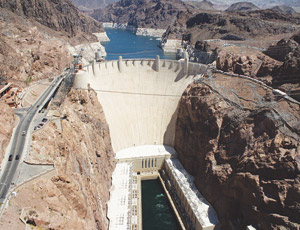Hoover Dam, the Depression-era engineering marvel, turns 75 this month. While its new bridge crossing is set to open in November, the concrete monolith also is marking a dubious milestone this year—a 54-year low point for its water level, which threatens the dam’s hydroelectric output.

Lake Mead dipped to 1,085 ft in September, less than 40% of its capacity, following a decade of boom growth and drought. As a result, Hoover Dam may have to shutter its 17 Francis-type hydroelectric turbines, each generating 130 MW, by 2013. The facility also has two 60-MW turbines and two 3-MW service generators. Lake levels have been dropping by 10 ft annually and cannot feed the turbines below 1,050 ft. “It was designed as a high-elevation dam,” says Pete DiDonato, dam facilities manager for the U.S. Bureau of Reclamation.
The 2,074-MW dam provides electricity to 1.3 million people in Arizona, Nevada and California, generating 4 billion kW hours of electricity annually, under normal conditions. But falling water levels have reduced operational capacity. Lake Mead loses 100,000 acre-ft of water every time the surface level drops one ft, equal to 5.7 MW less power.
Dam hydroelectric power is marketed, based on availability, through the Western Area Power Administration. “If availability drops, everyone’s allocation drops,” says a spokesman. “Individual utilities will have to make [up] the shortfall themselves.” Hoover Dam’s hydroelectricity is about 18¢ per kWh, says WAPA, while power from natural-gas plants ranges in cost from 25¢ to 38¢ per kWh.
Fast-growing southern Nevada has undertaken aggressive conservation measures, since Lake Mead provides the Las Vegas valley with 90% of its water. The water authority—which, since 1999, has been paying residents and businesses $1.50 per sq ft to replace sod with drought-tolerant alternatives—has converted more than 125 million sq ft of landscaping and saved an estimated 25 billion gallons.
The agency also is building a $447-million third raw-water intake, in case receding lake levels render existing infrastructure inoperable. General contractor Vegas Tunnel Constructors LLC, a joint venture of S.A. Healy Co., Lombard, Ill., and Italy’s Impreglio S.p.A., is set to finish by 2012, enabling the dam to draw water from a deeper source point.
“The lake surface level has dropped 111 ft since 2000,” water authority spokesman Bronson Mack says. “The third intake is critical for southern Nevada to continue accessing water and protect us from declining lake levels.”
The U.S. Bureau of Reclamation, which owns and manages the dam, is taking similar precautions. It recently awarded Charlotte, N.C.-based Andritz Hydro Corp. a $3.4-million design-manufacture contract for a new “wide-head” turbine runner, the waterwheel portion that drives the generator, on one of its Nevada-side units. “We are approaching the bottom of the efficiency curve,” DiDonato says. “Air bubbles are forming on the suction side of the turbine.”
The wide-head bucket design should reduce cavitation, or air bubbles, that pit metallic turbine parts, reducing efficiency and increasing wear and tear. It will additionally draw water deeper, at 1,000 ft. The new runner is set for dam delivery in February 2012. If it performs as anticipated, BLM has an $11.5-million contract option for three additional runners that would arrive in 2013 through 2015. Runners do not increase generation capacity.
There is a 50% chance that Lake Mead could be dry by 2021 under current climate-change and water-usage scenarios, according to the La Jolla, Calif.-based Scripps Institution of Oceanography. It says there is a 50% chance that water levels will drop too low for hydroelectric power generation by 2017. “It depends on what the runoff will bring next winter in helping increase those lake levels,” Mack says. “We continue to see good response from the community from our conservation program. We don’t want to get complacent.”

Post a comment to this article
Report Abusive Comment